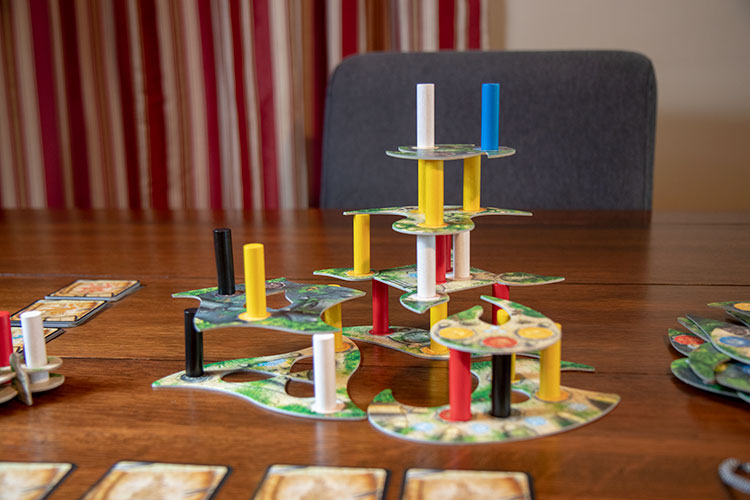 Back in October, I compiled my list of my Top 10 Stacking Games. Many excellent titles graced that list, from easy to play Rhino Hero to the excellent Junk Art. No matter your preferences, there are plenty of games for the dexterity builder in all of us.
Back in October, I compiled my list of my Top 10 Stacking Games. Many excellent titles graced that list, from easy to play Rhino Hero to the excellent Junk Art. No matter your preferences, there are plenty of games for the dexterity builder in all of us.
Recently, I stumbled across a copy of Menara, a stacking game with a very nice table presence and was determined to know more. To feed my ever-growing love of dexterity games, I sought out a review copy from publisher Zoch Spiele, who happily sent one across the ocean to us. Would Menara have made its way onto that top 10 list if I’d played it sooner? Let’s find out.
Menara is a stacking game for 1-4 players that takes about 30 minutes to play. Menera works well at all player counts.
Game Overview:

The gameplay in Menara is both simple to learn and challenging to play. The goal is to create a tower with the required number of floors when the game ends.
A player’s turn has four parts:
- Optionally exchange any amount of pillars with ones from the Camp
- Draw a construction card. You can choose either easy, medium, or hard.
- Execute the requirements of the construction card. Most will have you stacking one or more pillars onto the temple floors. Pillars must be placed in matching color circles. If you can’t fully complete a card, it gets turned face down and it becomes another floor requirement.
- Replenish your pillars
If you ever fully fill up the circles on a floor, a new floor is immediately placed in the temple. This floor can be anywhere, even on the table. However, if you do add it to the table, expanding the base of your temple, the height requirement of the tower is increased by one.
The game ends when either the construction cards are all gone, all the pillars are pulled from the bag, or all the floors have been placed. If one of those occur and the players have the required number of levels, they win. Alternatively, if the tower ever falls, the players lose.

Game Experience:
Menara is a simple game to learn; but winning it can be anything but. Players will need both a deft hand a solid strategy if they hope to win. This is because they game doesn’t end simply when the required amount of floors are built, but only when one of the above conditions are met. Players could conceivably reach the required number of floors halfway through the game, but they still need to maintain the stability of their structure until they reach an end game condition. However, just one collapse and it’s a loss for the players.

Surprisingly, Menara also incorporates a bit if strategy and resource management. This isn’t just a game of grabbing a pillar and placing it. For one, the pillars have an uneven number of colors. There are more yellow pillars than white ones, for example. So, you have to be aware of what’s in your supply before you draw your construction card. I’ve had turns where I wasn’t paying close enough attention, and I drew a card that required me to fill a floor complete. Since I didn’t have the right colors of pillars for any open floor, that was a failure and added another level requirement for us.
Speaking of the construction cards, I loved having three different difficulty levels. Your first inclination will to always draw the easy ones. However, there are fewer easy than medium, and fewer medium than hard. Which means that if you draw all easy ones at the start, you’ll be left with only hard ones late in the game, when the tower is a lot more unstable. So, there is definitely some strategy to drawing the right card at the right time. I like to save at least a few easy cards for the end game.
If I had a gripe about Menara, it’s that the rulebook could be better. Some rules are unclear, requiring trips online to find the answer. While the overall gameplay is fine to pick up, the rulebook could have definitely used a bit of TLC.

Final Thoughts:
Had I played Menara 6 months ago, it would have defiantly made my Top 10 Stacking Games list, most likely in the Top 5. This is a great title that’s both clever and addicting. The odd shapes of the floor and the difficulty of winning will have you coming back early and often for another challenge. Sometimes dexterity games can get in their own way with too much complexity for what it is (Flick ‘Em Up I’m looking at you), but Menara manages to avoid that pitfall. The rules overhead, while more than others in the same genre, aren’t enough to put me off bringing Menara out to the table fairly regularly.
Final Score: 4 Stars – An excellent stacking game that will challenge your dexterity skills and strategy.
 Hits:
Hits:
• Easy to learn game play
• Challenging to win
• Strategic decisions to be made
Misses:
• Rulebook could be clearer
























That looks very much like Villa Paletti https://boardgamegeek.com/boardgame/2596/villa-paletti which was by the same publisher originally (I think) and won the Spiel des Jahres.
Interesting. I had not seen Villa Paletti before, but it is the same publisher. Perhaps Menara is based on that game (appears different though).